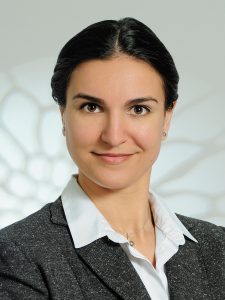As the use of artificial intelligence (AI) dramatically increases globally, concerns have arisen over the energy consumption required to train AI models. It’s estimated that training AI models like GPT-3 consumes as much energy as 130 U.S. homes annually or streaming 1,625,000 hours of Netflix. Professor Gina Adam of the Electrical and Computer Engineering (ECE) Department was awarded the Department of Energy (DOE) Early Career Research Award to support her work in developing brain-inspired hardware and algorithms that consume significantly less energy than current AI models.
The U.S. Department of Energy (DOE) developed its Early Career Research Program (ECRP) to provide funding to empower the next generation of America’s scientific workforce. The ECRP supports exceptional researchers early in their career, when many conduct their most career-defining work. In 2024, the ECRP’s highly selective peer review process yielded 91 awardees who were awarded roughly $138 million in funding. Prof. Adam’s award is for approximately $898,000 in funding for five years focused on developing energy-efficient neuromorphic technologies for scientific computing.
Prof. Adam’s research involves developing novel spiking neural networks capable of learning and adapting at scale. She collaborates with neuroscientists and investigates the role of foundational neuroscience concepts, like cell assemblies and spontaneous resting-state dynamics, in hardware-relevant network models. Adam’s work will explore analog devices with adjustable time parameters to enhance neuronal and synaptic diversity within neural network hardware systems.
“Interdisciplinary collaborations with neuroscientists are key to figuring out what are the key neuroscience insights that should support the development of neuromorphic technologies,” Adam said. “I am very thankful to be able to collaborate with colleagues who can provide open inventories of experimental neuroscience data.” Access to these inventories help Adam and her team understand the neuronal and synaptic diversity present in the brain and what structural and functional properties of the brain have to be translated into neuromorphic hardware.
Prof. Adam’s Early Career Research Award is one part of her collaborative relationship with DOE. Adam is also funded by DOE through the Collaborative Research in Computational Neuroscience (CRCNS) program in collaboration with Professor Giorgio Ascoli from the Bioengineering Department and the Center for Neural Informatics, Structures, and Plasticity at the George Mason University. This work is focused on drawing inspiration from the rodent hippocampus for the development of neuromorphic technologies.
In September 2024, Prof. Adam served as a co-chair of the DOE Neuromorphic Computing for Science Workshop, leading more than 70 participants with interdisciplinary expertise in neuroscience, microelectronics, and large-scale simulation to discuss and propose four priority research directions for neuromorphic computing.
Prof. Adam’s collaboration with neuroscientists and the DOE exemplify the value of interdisciplinary research. By bringing together experts from different disciplines, researchers can develop tailored, cross-cutting solutions for the challenges presented by AI. Professor Adam’s work advances the neuromorphic computing field and proposes a promising future for how we may train AI models in a more energy efficient way.


